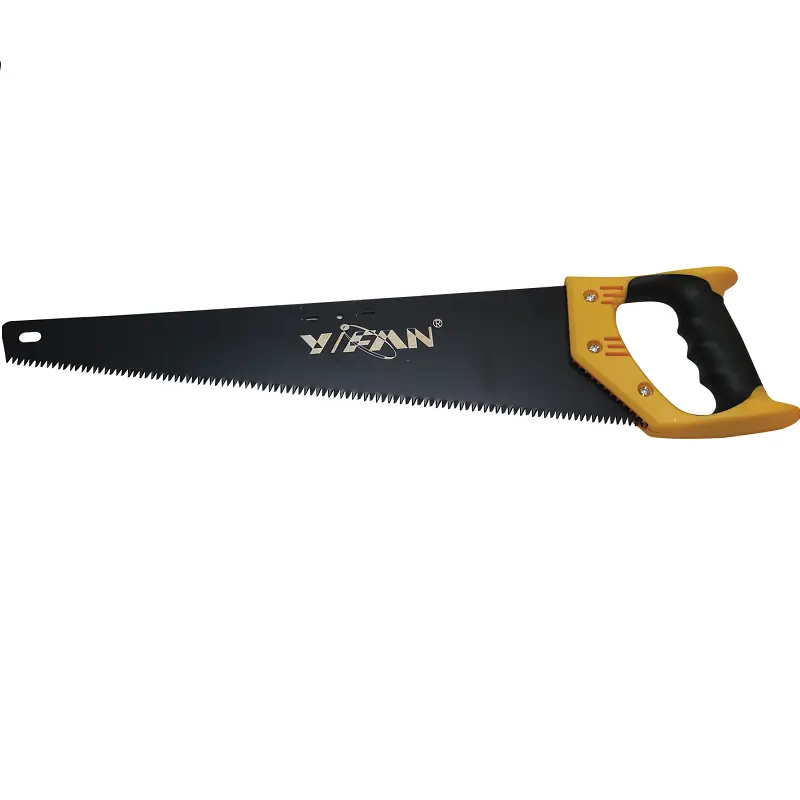The hand saw is an essential tool in woodworking and various manual tasks, characterized by its intricate structure. At its core, the hand saw consists of three main components: the saw blade, saw handle, and connecting parts.
• Saw Blade: Typically made from high-quality carbon steel or alloy steel, the saw blade is designed for durability and toughness. The teeth of the saw are precisely crafted, with the tooth pitch being adaptable based on the intended use. For instance, coarse teeth are perfect for rough cuts, while fine teeth excel in making smooth, precise cuts. The length of the saw blade varies, allowing it to tackle different cutting tasks efficiently.
• Saw Handle: The handle is crafted from various materials, including warm wood, lightweight plastic, and non-slip rubber. Ergonomically designed, the handle provides a comfortable grip, reducing fatigue during extended use. This comfort is crucial for maintaining control and precision while cutting.
• Connecting Parts: These components securely fasten the saw blade to the handle, ensuring stability and safety during operation. A well-constructed hand saw minimizes vibrations and enhances user control, making it an indispensable tool.
Manual Drive, Efficient Cutting
The operation of a hand saw is straightforward yet effective. The user holds the saw handle and employs arm strength to perform a push-pull motion.
• Pushing Forward: As the user pushes the saw forward, the sharp teeth bite into the material, effectively cutting through fibers. This action requires minimal effort when using the appropriate saw for the material type.
• Pulling Back: During the pull-back motion, the saw removes debris, clearing the cutting path for the next stroke. This rhythmic process allows the operator to maintain a steady pace, adapting to the material's resistance and characteristics, which is essential for achieving clean cuts.

Diverse Classification, Precise Adaptation
Hand saws come in various types, each tailored for specific tasks:
• Woodworking Hand Saws: These are designed for wood processing, easily handling tasks like cutting boards and breaking down logs. Their sharp, durable blades ensure efficiency in various woodworking projects.
• Gardening Hand Saws: Lightweight and flexible, these saws are ideal for pruning branches and maintaining garden aesthetics. They allow gardeners to navigate tight spaces and make precise cuts without damaging surrounding plants.
• Blade Shapes: Hand saws are also categorized by blade shape.
• Straight saw blades are perfect for straight cuts, while curved saw blades allow for intricate designs and detailed work, enabling users to explore their creativity.
Widely Used, Irreplaceable
Hand saws have maintained their relevance in both professional and DIY settings. In woodworking shops, they are essential for crafting beautiful furniture and ensuring structural integrity in building projects. In the gardening field, they assist in shaping landscapes and promoting plant health.
The hand saw's portability, ease of use, and precision make it a staple in toolboxes worldwide. Despite advancements in technology and the rise of power tools, the hand saw remains an irreplaceable tool for many craftsmen and hobbyists. Its ability to deliver accurate cuts and versatility across various applications ensures that it will continue to be a favorite among those who appreciate the art of manual labor.
In conclusion, the hand saw is not just a tool; it is a trusted companion for anyone engaged in woodworking or gardening. Its exquisite design, efficient operation, and adaptability make it an invaluable asset, empowering users to bring their creative visions to life.
Post time: 12-06-2024




